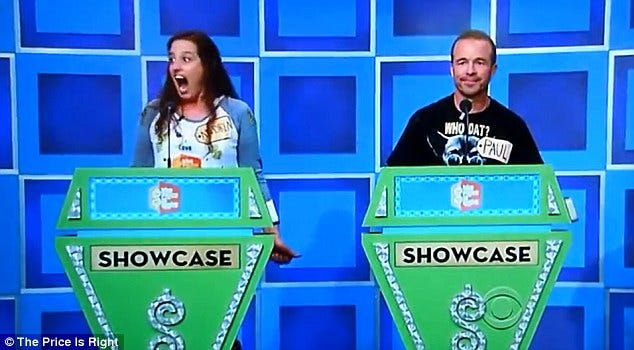#6: Quo Vadis Use Case Education Session
Webinar interview with Cary Dunst and Charmagne Jacobs of AdSlot
Welcome to Quo Vadis, your periodic source for fresh programmatic news and off-the-beaten-path perspective. If someone was kind enough to share this with you, then you’re in luck! Just click here to join the conversation.
Chatting With AdSlot
Use Case Education Session
This past Wednesday I interviewed Cary Dunst and Charmagne Jacobs of AdSlot. We discussed a handful of key topics...
Direct buying.
Publisher audience ID.
Deal ID Automation.
Productivity gains.
DV360 bid stream market size.
Getting the ad-buying job done better, faster, cheaper...
Check out our 30-minute chat. Comments welcome.
Bring Out the Quants
Lucky Winners!!!
In our inaugural Quo Vadis Issue #1 on March 4, we gave our readers a programmatic math question about expected value bidding. Two lucky winners got the answer right and won a free paid subscription to Quo Vadis+ for one whole year! Treasure it… the gift that keeps on giving! Congrats!
Sharpen your pencils: We’ll run a new media math question in the main Quo Vadis issue coming out next week!
Expected Value Bidding
Most DSPs will you tell they do some form of expected value bidding (EVB), but in reality, they don’t. And if they do, it’s usually not with the advertiser’s interests in mind.
What is EVB? It’s Easy. Let’s say you’re willing to pay $10 for the ideal impression. The ideal impression is one that is on target, to a human, brand-safe, renders on a browser page or in an app, and is viewable.
Now, what is the probability that an impression makes it through all those obstacles? Is it 100%? Unlikely. Is it somewhere between 0% and 100%? Yes, it must be.
Consider two examples:
Example 1:
On target = 100%
Human = 50%
Brand-safe = 90%
Renders on a browser page or in an app = 80%
Viewable = 50%
Overall Probability = 100% x 50% x 90% x 80% x 50% = 18%
So, the expected value price you should bid is $1.80 = $10 x 18%.
If you bid a flat price of $10 and win the impression, you lose twice. You lose $8.20 because you overpaid. That’s called the winner’s curse. You lose twice because you paid ad taxes to many supply chain actors based on the full $10 winning bid. That’s foolish.
Example 2:
On target = 100%
Human = 0%
Brand-safe = 90%
Renders on a browser page or in an app = 80%
Viewable = 50%
Overall Probability = 100% x 0% x 90% x 80% x 50% = 0%
In this case, the expected value price you should bid is $0.00 = $10 x 0%. When any of these silly ad quality obstacles fall to 0%, the entire chain collapses to 0%.
In other words, if an impression is on target, but the user is a bot instead of a real person that buys stuff, it no longer matters if the content is not brand-safe or viewable.
And noodle on this one. If the verification reporting says the user behind the impression was on target, but in the very next test was found to be a bot, how do you reconcile such a strange anomaly?
Programmatic Word of the Day: Anomaly (a·nom·a·ly)
Something that deviates from what is standard, normal, or expected. That’s what you get in programmatic without EVB.
Why Don’t DSP Do EVB For Advertisers?
Unfortunately, if DSPs bid the real expected value of the ad quality on offer in programmatic auctions, win rates would drop, prices would deflate and so would all the fee taking that goes along with it. ‘Nuff said.
Why Don’t Advertisers Innovate and Bid Using EVB?
If advertisers replaced what game theories call weak bidding strategies with dominant strategies like EVB, they would end up with giant budget gaps. No one likes budget gaps in programmatic land. They are not allowed to happen. Period.
It is simply easier to spend money on impressions with zero chance of getting the advertising job done than having to deal with budget gaps. We think that explains a lot about the state of programmatic.
Rule of thumb — Auctions are competitions. If you’re not prepared to compete like hell, then you should exit the game. If you are prepared, then when you win you know exactly what you’ve won.
Wanna learn more about expected value bidding? Check out our thesis called “the Struggle” — it’s all you need to know.
Ask Us Anything (About Programmatic)
If you are confused about something, a bunch of other folks are probably confused about the same exact thing. So here’s a no-judgment way to learn more about the programmatic ad world. Ask us anything about the wide world of programmatic, and we’ll select a few questions to answer in our next newsletter.
Join Our Growing Quo Vadis Community
Was this email forwarded to you? Sign up for our monthly newsletter here.
Get Quo Vadis+
When you join our paid subscription, you get at least one new tool every month that will help you make better decisions about programmatic ad strategy.
Off-the-beaten-path models and analysis of publicly traded programmatic companies.
Frameworks to disentangle supply chain cost into radical transparency.
Practical campaign use cases for rapid testing and learning.



